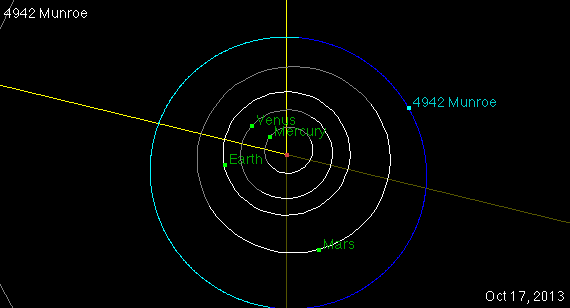I would like to formally welcome my pal Randall Munroe to the club. The asteroid club, that is: The creator of the Web comic xkcd just got an asteroid named after him.
Asteroid 4942 Munroe (nee 1987 DU6) orbits the Sun on the inner edge of the main asteroid belt—it’s no threat to Earth—about 330 million kilometers (200 million miles) out. It’s too small to measure its size directly at that distance, but judging from its brightness, it’s very roughly 10 km across at most.
Appropriately, it’s an X-type asteroid, which just refers to some features seen in its spectrum (the light from the asteroid broken up into thousands of individual colors, which can give clues to its composition). It has a fairly typical orbit, though it’s somewhat more elliptical and tilted with respect to Earth’s orbit:

Plot by NASA/JPL
The blue line is the orbit of 4942 Munroe. If you go to the Jet Propulsion Laboratory website you can play with the geometry and see how it’s shaped. By the way, astronomers call the ellipticity of an orbit its eccentricity, so it’s fair to say that 4942 Munroe is slightly eccentric. Huh.
I’ll note that this asteroid was discovered in 1987, when Randall was only a few years old, but it was recently renamed after him when a couple of xkcd fans submitted his name to the International Astronomical Union. I’ll note how grossly unfair it is that although he just got his own rock, I’ve had one for years, and my asteroid is only 1.3 km across, not even a mile. Clearly, the IAU hates me.
But this presents a fun opportunity. A few years ago, a Bad Astronomy reader got images of 165347 Philplait and created a nifty animation of it moving against the background stars. I poked around and could find no such images of 4942 Munroe. So here you go, folks: A chance for xkcd fame. Be aware that right now it’s near the Sun in the sky (you can see that in the orbit diagram above, which I set to Oct. 17 for no particular reason at all), so it’ll be early 2014 before it’s visible again, rising just before the Sun does in the morning. Mark your calendar.
